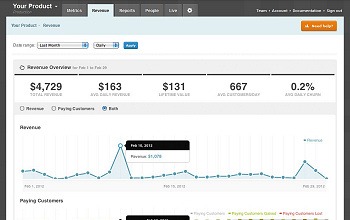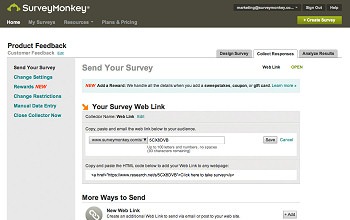12 tools of a modern marketer
A list of reliable online applications that are useful – or actually necessary – in marketing and especially in internet marketing.
Software moves from local computer discs to the cloud – even such giants as Microsoft Office appear in a version that is available through the browser. Among hundreds of free and paid for applications available online (in SaaS model), there are at least some that deserve a marketer’s attention.
Here I skip the most basic and obvious internet marketing tools, i.e.:
- your own website and its CMS,
- Google search engine,
- social networking services (Facebook, YouTube, LinkedIn, Google+ etc.).
1. CRM.
Basically all large companies and corporations use dedicated solutions such as CRM/ERP. Their functionalities cover all areas of company’s activity – including marketing as one of many elements.
These solutions are rarely ideal but – from the perspective of a cog in the machine – there is hardly any other choice.
On the other hand, there is no rule with micro-, small and medium-sized businesses but it’s quite often the case that no CRM is used by them.
Every company possesses some data about its clients and prospects and every (well, almost every) company takes some marketing actions targeted at them. And Excel is absolutely NOT the tool to store (and analyze) the history of contacts.
Reliable online CRM solutions include: SalesForce, SugarCRM i Zoho CRM.

2. Website statistics.
What’s fundamental for e-marketing analytics is to know the sources of website traffic and the behaviours of users.
Here, as regards traffic tracking systems, Google Analytics has basically the monopoly. It is used by – depending on the source – 82% to 98% of websites.
Other websites use alternative solutions generally not because of the (almost unknown) limit of 10,000,000 views per month, above which GA does not guarantee processing. The simple reason is that there are systems providing more marketing-useful information because they focus on individual users instead of general numbers. One of them is KISSmetrics, which is often praised on Twitter.

3. Tracking your Google position.
the first position in Google search results (SERP) attracts 53% of clicks. For business-essential key words, every change within the top positions has a significant effect on sales. That’s why it’s good to monitor the effects of positioning activities and verify the actions taken by the SEO specialists we hire.
A very good services like these are provided by Positionly, a website that allows you to track positions in different language versions of Google.

4. SEO.
Regardless of whether optimization is given to an agency or dealt with internally, some knowledge about website parameters and the most important key words is always necessary, at least for the purposes of generating optimized website content.
SEO is ‘the winning of Google’s favour’. And it is Google that makes available the most important tools supporting webmasters in doing so.
Google Webmaster Tools help optimize websites, Google Keyword Tool is the source of knowledge about how popular particular key words are and about how strong your competition is and Google Trends – as the name suggests – presents current trends in what is searched.
A more advanced tool, which is often used by SEO specialists, is SEOmoz – a set of mechanisms that make it easier to track SEO campaigns, monitor links or even spy on your competition.

5. A/B tests.
For marketing, one of the most important advantages of the Internet is that you can optimize your actions on an on-going basis, i.e. when the campaign is running, using the information about the effectiveness of the campaign that comes in real time (or close to real-time).
It’s the easiest and the quickest to take simple decisions – decisions about whether to choose one or the other of two options, such as two banner creations. That’s made possible by ‘A/B tests’ which automatically decide which option is more effective.
A/B tests are a functionality built into many online applications, such as interfaces of advertising systems. They are also one of basic website functions that facilitate creating landing pages, i.e. simple web pages whose aim is to convert traffic from advertising campaigns. An example of such a website is Unbounce.

6. E-mail marketing.
Newsletters, autoresponders and e-mailings are still one of the most effective online actions. They are not able to build such great scope as social networking services but they generate high conversion rates and are often used as an intermediate medium between the campaign (e.g. an inbound marketing campaign) and the commercial message (the offer).
In ‘How to handle emailing properly’, I explain in detail why dedicated e-mail marketing applications are the best way to send emails to many recipients.
What I can recommend from the top of the list of e-mail marketing systems is MailChimp.

7. Surveys.
Online polls enable you to obtain valuable data from users (clients, subscribers, visitors of your company website etc.) in a swift and friendly manner. And – somewhat in disguise – they can transfer some information or even an offer.
Online applications to run polls facilitate quick and easy creation of visually attractive questionnaires, support the collection of replies and then help perform an initial data analysis. I say ‘initial’ because in the case of more complex research the data are anyway exported to be processed further (e.g. with a spreadsheet).
The leader in the field is SurveyMonkey.

8. Synchronizing social networking media.
Despite the hegemony of Facebook, the marketing importance of other social networking services – which are less universal but still popular with a specific type of users – is on the rise. Here you have LinkedIn (business), Pinterest (women), YouTube, MySpace (music), etc. Twitter is also coping quite well trying to be universal but still it differs much from Facebook because of its form.
My point is that it’s not enough today to have your brand present in just one of the social networking services. You need to publish your content in some of them and synchronize that properly.
HootSuite, SproutSocial or Buffer are the applications that can help here. Using them you can really control a lot of social networking channels and plan, automate and analyze the publication of engaging content.

9. Monitoring social media.
The services mentioned above have certain analytical tools. However, to monitor your brand in the Internet and especially in the social networking services it’s best to use specialized software.
An example of such a system is Trackur.

To track your brand in the net in a very simple way or in fact to catch any mentions of it on websites, blogs and portals, you can use Google Alerts.
10. Marketing automation.
This high-sounding name is given to ‘all-in-ones’ that offer many of the functionalities mentioned above (plus some more). Their advantage is at the same time quite a big disadvantage because when you decide on so many tools from one provider you limit your choices at a lower level. In other words, you have to adjust – to some extent – your own processes to the procedures of an application you choose.
SalesManago is a relatively new marketing automation system that is trying to compete with such giants as HubSpot.

11. Presentations.
For marketing department employees, PowerPoint is a nightmare. Internal presentations, sales support for sales reps etc. Luckily, there are alternatives to this program. They are not that universal and editing with them at a later stage is not that easy but perhaps that’s also their advantage. Above all, however, a presentation doesn’t look rough and boring when prepared with them. (Still, there are people who can make a lot even with PowerPoint).
Presentations created with the use of Prezi are dynamic zoom-ins, rotations, zoom-outs and other types of panning. They are parts of a large surface with information on it displayed on the screen. There are no slides here but groups of information – of different size – displayed in one frame.
By contrast, SlideRocket is based on slides but thanks to its potential the slides can look really fantastic and still, SlideRocket presentations are not only slides. The software also enables you to publish presentations on-line, analyze their audience ratings and even interact (communicate with recipients in real time).

12. Graphics and video edition.
Not every marketing department has its own graphic designer and, after all, subcontractors are not at their beck and call. Sometimes you may simply need your picture be slightly edited just right now.
Good graphic solutions and video edition software costs. That’s, however, a smaller problem than to learn how to use it. Such programs have many functionalities and because of that their interfaces are complicated. That in turn makes them difficult to use, at least at the beginning.
What comes to aid here are online applications, such as pixlr, which is a graphics editor available in advanced and simplified versions (and also as a mobile application), and WeVideo, which is a cloud-based video editing platform.

This is the end of ‘12 tools of a modern marketer’ but I still have two extra points that I didn’t want to include in the official list because I’m connected with these applications.
13. Website availability monitoring.
Regardless of the infrastructure quality, a website failure can happen any time and for various reasons (and very often just simply because of a human error). And the worst is when your website is unavailable during advertising actions – because until the administrator reacts and removes the problem a good part of your budget will be wasted when the users attracted by the campaign reach nothing.
Such situations make it reasonable to use external website monitoring, such as Website-Monitoring.com that picks up not only website unavailability events but also improper functioning of the website.

14. Tracking results of many websites.
Marketers responsible for promotion of many websites (e.g. product websites) don’t have an easy life. Traffic statistics, effects of SEO actions, results of actions in social networking services – all these data are available but in different systems and separately for each website.
Webmastat is a webmaster’s ‘dashboard’. Properly configured, it downloads data from Google Analytics, Facebook, Twitter, SEOmoz etc. on an on-going basis and it makes it easier to go over and compare them. It also includes a functionality of sending alerts the moment a predefined value of given statistics is exceeded.

And now that’s really the end of the list.
And what about you? Do you know any other online applications that make marketers’ lives easier?
